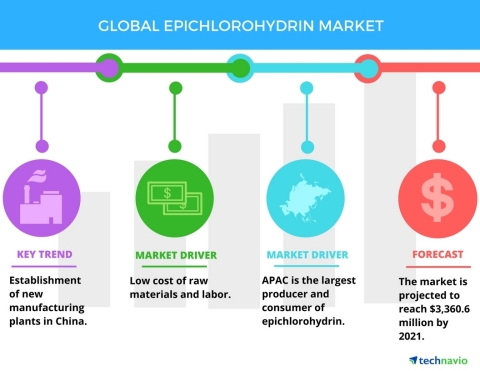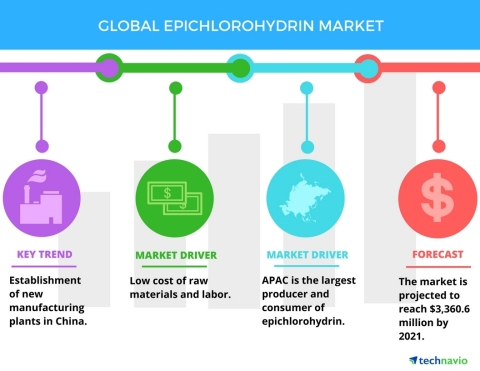LONDON--(BUSINESS WIRE)--Technavio’s latest market research report on the global epichlorohydrin market provides an analysis of the most important trends expected to impact the market outlook from 2017-2021. Technavio defines an emerging trend as a factor that has the potential to significantly impact the market and contribute to its growth or decline.
The global epichlorohydrin market is growing at a moderate pace because of the rise in the demand in regions, such as Europe, the Americas, and the Middle East and Africa. The paints and coatings segment accounted for largest market share of around 30% of the global epichlorohydrin market in 2016.
This report is available at a USD 1,000 discount for a limited time only: View market snapshot before purchasing
Buy 1 Technavio report and get the second for 50% off. Buy 2 Technavio reports and get the third for free.
The top three emerging market trends driving the global epichlorohydrin market according to Technavio research analysts are:
- Bio-based methods replacing synthetic methods
- Establishment of new manufacturing plants in China
- Growth of epichlorohydrin-based resins in water treatment industry
Looking for more information on this market? Request a free sample report
Technavio’s sample reports are free of charge and contain multiple sections of the report including the market size and forecast, drivers, challenges, trends, and more.
Bio-based methods replacing synthetic methods
The availability of glycerine as a byproduct from biodiesel production has influenced the development of technologies that use glycerine as a raw material to produce value-added products, such as epichlorohydrin. The conventional method used propylene and chlorine to produce epichlorohydrin. Glycerine can also be reacted with hydrochloric acid (HCl) to form an intermediate called dichlorohydrin, which can be converted into epichlorohydrin.
“The cost of glycerine is very high compared with propylene. However, consumers are becoming more aware of the harmful effects of propylene on the environment and the benefits of using bio-based products. Bio-based methods can positively influence the epichlorohydrin market and drive its growth in the future. The US is investing heavily in R&D to produce epichlorohydrin from glycerine,” says Mohd Shakeel Iqbal, a lead analyst at Technavio for specialty chemicals research.
Establishment of new manufacturing plants in China
The number of manufacturing plants is increasing in APAC, especially in China. This is because of the higher consumption of epichlorohydrin in China compared with other countries. The demand in China is mainly increasing because of the rise in production of epoxy resins, which have a wide range of applications. They are used in various products, including paints and coatings, adhesives, and textiles.
The Dow Chemical Company is planning to increase its presence in Asia. It has invested around USD 100 million in the construction of a new epichlorohydrin facility in China. The new epichlorohydrin facility will use glycerine as a feedstock instead of propylene. This is expected to drive the growth of the global epichlorohydrin market.
Growth of epichlorohydrin-based resins in water treatment industry
Epichlorohydrin has the property of disinfection. Thus, it can be used to kill fungi and bacteria. It has a wide range of applications (fungicides and insecticides) in the field of agriculture. It can be used to treat water and kill harmful germs to make water safe for drinking. Epoxy resins are mainly used for drinking water supplies because they contain no harmful agents that can affect humans.
“Epichlorohydrin is the key raw material used in the manufacture of epoxy resins, which are used in the paint, electronics, adhesive, automotive, and construction industries. This, in turn, is contributing to the growth of the epichlorohydrin market. Most of the epoxy resin-manufacturing industries are the largest consumers of epichlorohydrin,” says Shakeel.
Browse Related Reports:
- Global Microcrystalline Cellulose Market 2017-2021
- Global Benzaldehyde Market 2017-2021
- Global Oilfield Process Chemicals Market 2017-2021
About Technavio
Technavio is a leading global technology research and advisory company. Their research and analysis focuses on emerging market trends and provides actionable insights to help businesses identify market opportunities and develop effective strategies to optimize their market positions.
With over 500 specialized analysts, Technavio’s report library consists of more than 10,000 reports and counting, covering 800 technologies, spanning across 50 countries. Their client base consists of enterprises of all sizes, including more than 100 Fortune 500 companies. This growing client base relies on Technavio’s comprehensive coverage, extensive research, and actionable market insights to identify opportunities in existing and potential markets and assess their competitive positions within changing market scenarios.
If you are interested in more information, please contact our media team at media@technavio.com.




